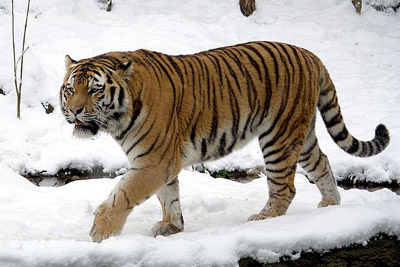Siberian Tiger
Category: Big Cats

Facts about Siberian Tigers. "Scientific name for Siberian Tiger is Panthera tigris altaica". The Siberian Tiger is a breed of tiger that exists in the Sikhote Alin peak region. The Siberian Tigers are sometimes called as the Amur tiger.
Appearance of Siberian Tiger
The Siberian Tiger breed appears in rusty-yellow, or reddish-rusty in color, with thin black transverse lines. The length of the body of this tiger is about 59 inches (150 cm), zygomatic width being 180 mm, condylobasal length of the head being 250 mm and the upper carnassial tooth is more than 26 mm long. It has an extensive, flexible body standing on small legs with a quite long tail. The Siberian Tiger breed is normally 2 to 4 inches (5 to 10 cm) taller than other breeds such that the height ranges from 42 to 43 inches (107 cm to 110 cm).
Head of Siberian Tiger
The head of the Siberian tiger breed is exemplified by its huge size, and resembles the head of a lion, and diverges in the structural characteristics of the lower jaw and the comparative length of nasals. The facial area is very influential and extremely broad in the area of the canines. The head prominences, particularly the crista occipitalis and sagittal crest are extremely high and sturdy in old male tigers, and habitually much more enormous than generally observed in the biggest heads of Indian tigers. The size difference in the heads of the Siberian Tiger breed ranges from 13 to 15 inches (331 mm to 383 mm). A female Siberian Tiger head is smaller at all times and by no means, as heavily fabricated and healthy as that of a male tiger. The stature of the sagittal crest in middle-part of the Siberian Tiger breed attains as much as 1 inch (27 mm) and in posterior part of the Siberian Tiger breed equal to 1 7/8 (46 mm).
Coat and fur of Siberian Tiger
The ground color of the pelage of the Siberian Tiger breed is habitually very pale, particularly in winter coat. The fur of this breed is fairly bulky, coarse and thin when compared to other breeds. The winter fur of the Siberian Tiger breed often looks quite hairy on the trunk, and is noticeably longer on the skull, virtually covering the ears. The whiskers and the hair on the top of the neck and on the back of the head are also deeply elongated. The backdrop color of the winter coat of the Siberian Tiger is usually less bright and tarnished when compared to that of the summer coat.
The average lifespan of the Siberian Tiger breed ranges from 10 years to 15 years in the wild, and 20 years in zoos.

 Back To Category Big Cats
Back To Category Big Cats